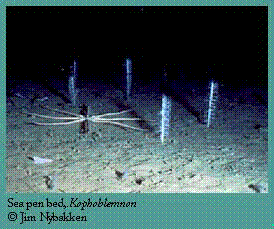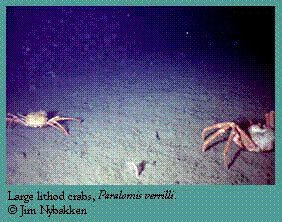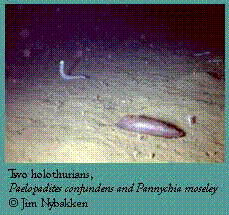Deeper Bottom Habitats
III. Deep Sea Sedimentary Megafaunal Communities (>2000 m depth)
 The MBNMS benthic invertebrate communities below 2,000 m in depth
are significantly less well known than the sedimentary invertebrate communities
of the continental shelf. The only sampling of this large area has been
by camera sled in 1988 and 1991; recent video and camera images taken from
the submersibles Mir and Alvin; and 32 beam trawls taken in 1991 and 1992
(Nybakken et al.1992a, 1992b). As a result we can only speak in general terms
about the communities, and only about the larger (megafaunal) organisms.
The MBNMS benthic invertebrate communities below 2,000 m in depth
are significantly less well known than the sedimentary invertebrate communities
of the continental shelf. The only sampling of this large area has been
by camera sled in 1988 and 1991; recent video and camera images taken from
the submersibles Mir and Alvin; and 32 beam trawls taken in 1991 and 1992
(Nybakken et al.1992a, 1992b). As a result we can only speak in general terms
about the communities, and only about the larger (megafaunal) organisms.
A total of 133 species were collected from 32 beam trawls in at three sites: Monterey Canyon, Pioneer Canyon and the Navy Ocean Disposal Site off San Francisco (the latter site is outside the MBNMS boundaries; (Nybakken et al. 1992b). The most abundant large invertebrates at all three sites were holothurian echinoderms. Other abundant taxa included ophiurans, anemones, pennatulaceans and echiurans. The most abundant holothurians were two species of the family Ypsilothuriidae. These animals burrow in the sediment and were not visible in camera sled surveys. Another burrowing holothurian, Molpadia spp., was usually third or fourth in abundance, while the burrowing sea star, Eremecaster , was fourth or fifth in abundance. Based on these beam trawl collections, it appears that the dominant invertebrates in terms of abundance are infaunal. These dominant infaunal organisms are all deposit feeders.
A somewhat different picture emerges from analysis of the camera sled data, which documents only those organisms visible on the surface. The camera sled survey of the Navy site in August 1991 viewed an area of the sea floor between 1,085 and 3,283 m in depth. The surface was dominated by two holothurians, Paelopadites confundens and Pannychia moseleyi, large numbers of several species of brittlestars of which Ophiomusium glabrum, Amphiura carchara and Amphilepis platytata were the most abundant, and several species of pennatulaceans of which Pennatula phosphorea and an undescribed species of Kophoblemnon were most abundant. Also very common was the corallomorpharian anemone Corallimorphus rigidus. These dominant species from this site seemed to occupy distinct depth zones. Common observations included dense pennatulacean beds and mostly soft sediments with only occasional hard outcroppings.
 The camera sled survey at the Monterey Canyon site in October 1988 viewed
an area of the sea floor between approximately 2,200 and 3,200 m. Here
the fauna seemed to be dominated by ophiuroids and holothurians and did
not appear to be as distinctly zoned. Pennatulaceans were less frequent
than in the Navy site and did not occur in dense beds. The assemblage of
dominant holothurians included the 2 dominant species from the Navy site
plus Benthodytes sanguinolenta and Scotoplanes globosa. However,
five additional species were observed at the Monterey Canyon site that were
not seen at the Navy site, including a super-abundant species of Peniagone.
In the Monterey Canyon site, chemical seeps were indicated by observed discolorations
of the soft sediments. Several species seemed associated with these areas,
including a species of the vent clam genus Calyptogena. Similar seeps were
not observed at the Navy site.
The camera sled survey at the Monterey Canyon site in October 1988 viewed
an area of the sea floor between approximately 2,200 and 3,200 m. Here
the fauna seemed to be dominated by ophiuroids and holothurians and did
not appear to be as distinctly zoned. Pennatulaceans were less frequent
than in the Navy site and did not occur in dense beds. The assemblage of
dominant holothurians included the 2 dominant species from the Navy site
plus Benthodytes sanguinolenta and Scotoplanes globosa. However,
five additional species were observed at the Monterey Canyon site that were
not seen at the Navy site, including a super-abundant species of Peniagone.
In the Monterey Canyon site, chemical seeps were indicated by observed discolorations
of the soft sediments. Several species seemed associated with these areas,
including a species of the vent clam genus Calyptogena. Similar seeps were
not observed at the Navy site.
High variance in the abundances of organisms in different trawls coupled with the visual records from the camera sleds strongly suggests that distributions of these megafaunal organisms is highly patchy, especially among surface-dwelling forms. As noted above, relative abundance of species differed significantly at the three sites. Dramatic changes in species abundance were also observed in different surveys of the same sites. For example, there was a major decline in the abundance of Paleopadites confundens between 1991 and 1992 at the Navy site, and Pannychia mosleyi and Ophiomusium glabrum were absent from all but one site in 1992. This dramatic change in abundance among dominant organisms was also mirrored in many of the less abundant species. The isopod Storthyngura was observed at the Pioneer Canyon site in 1992, but was not seen at any other site. Similarly, the small holothurians Peniagone and Elpidia appeared only at the Monterey Canyon site. Another particularly noticeable change in the 1992 sampling at all sites was the complete absence of the large lithod crab Paralomis verrilli.
 Quantitative analysis of differences between sites and between survey years
indicated that the megafauna associations at the same depth in the MBNMS
are really quite different at different sites. Results also suggested that
there are strong seasonal and yearly differences within the same site. Surveys
of the Navy site between years showed the highest similarity (80.8 percent
similarity between years, using percent similarity of mean species abundances
per 100 square meter surveyed). The Monterey Canyon site was the most different
from all the others (39.7 median percent similarity compared to other sites).
The Pioneer site was intermediate in similarity between the Navy site and
the Monterey Canyon site (Nybakken et al. 1992b).
Quantitative analysis of differences between sites and between survey years
indicated that the megafauna associations at the same depth in the MBNMS
are really quite different at different sites. Results also suggested that
there are strong seasonal and yearly differences within the same site. Surveys
of the Navy site between years showed the highest similarity (80.8 percent
similarity between years, using percent similarity of mean species abundances
per 100 square meter surveyed). The Monterey Canyon site was the most different
from all the others (39.7 median percent similarity compared to other sites).
The Pioneer site was intermediate in similarity between the Navy site and
the Monterey Canyon site (Nybakken et al. 1992b).
Unfortunately, these results cannot be compared to other local studies, as none have been published in the peer-reviewed literature concerning the benthic megafauna communities at the depths of 2,000 to 3,000 m. The closest areas for which data exist are off the Oregon and southern California coasts.
| < Previous - Section II. Faunal Assemblages on the Continental Shelf (40 - 600 m depth) |
||
